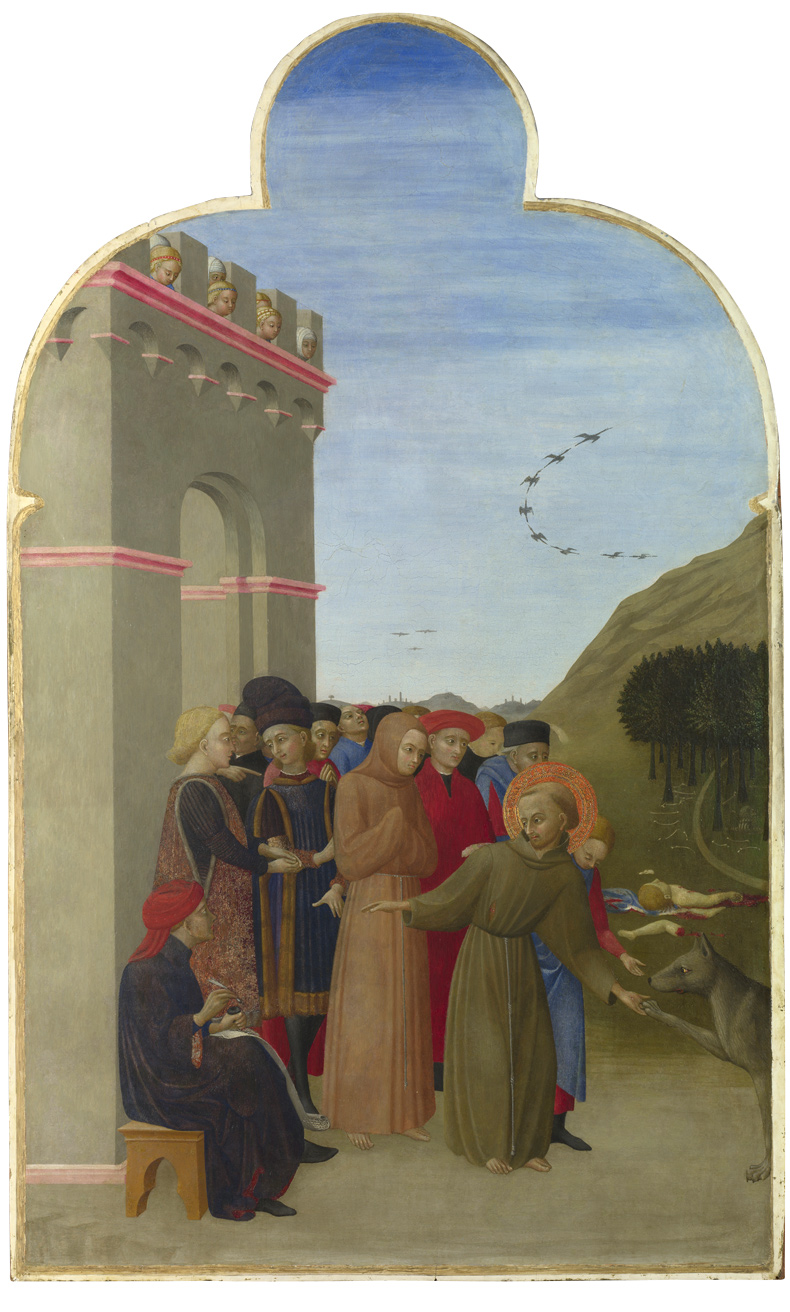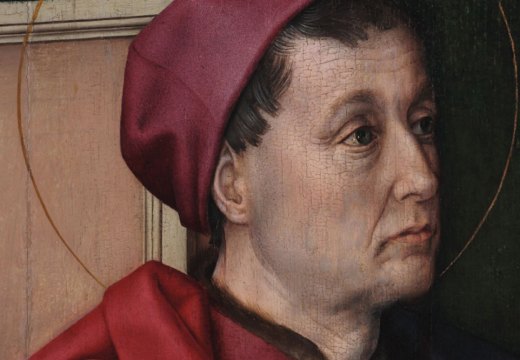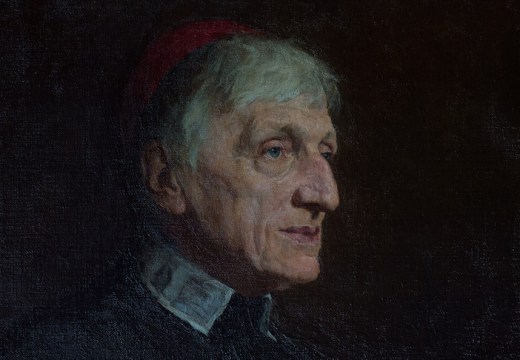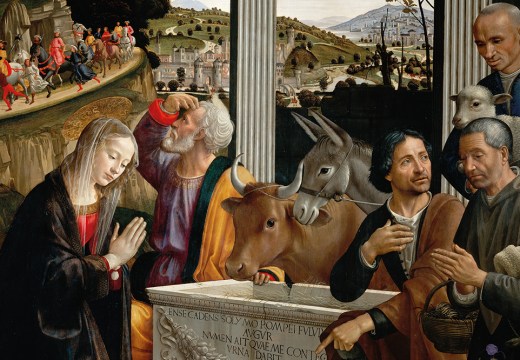From the July/August 2023 issue of Apollo. Preview and subscribe here.
Our understanding of Saint Francis of Assisi, now the subject of an exhibition at the National Gallery, has been shaped by the stories of his life told over the centuries. One of these, recorded after his death in 1226, describes how, on approaching a city, the saint was dismayed to learn that its bishop had set out to greet him arrayed in episcopal robes. As bishop and clergy drew near, Francis ‘caught sight of a heap of potter’s clay […] and lifting up his tunic, he stepped into the mud and began to tread the clay with his feet’. The act exemplified the saint’s embrace of poverty, while recalling the biblical account of God’s creation of Adam from the dust of the earth after it had been watered by rain. How apt, then, that the first room of an exhibition that spans the centuries with deft juxtapositions should feature a wall-based artwork painted with mud and water on a dark ground: River Avon Mud Crescent (2023) by Richard Long.
Flanking this, A Walk for Saint Francis (2022) recreates Long’s walk of eight days from Assisi over Monte Subasio via the remote places where Francis withdrew to pray. Single words or short phrases tell of sights and sounds seen on the way; these radiate like the spokes of a wheel, evoking the turning of the globe from night to day. Like the mud, these words – such as ‘cracked earth’, ‘stag beetle’, ‘larksong’ – are an appropriate overture to an exhibition in which Francis’s own words resonate through wall texts and precious parchments. In the second room, a facsimile of Francis’s tender letter to a faithful companion, Brother Leo, written on parchment no bigger than his palm, draws us in close; in the fourth room his celebrated ‘Canticle to the Sun’ (1224) is writ large upon the wall.
Humble materials, both depicted and actual, appear throughout the exhibition, linking the medieval to the contemporary. In Francisco de Zurbarán’s painting Saint Francis in Meditation (1635–39), the saint’s rough habit is rendered palpable by dramatic lighting, while his face is almost hidden in shadow. Elsewhere, a canvas titled Sacco (Sack) of 1953 by Alberto Burri is made largely of sackcloth sutured with stitches; a gash reveals a patch of vermilion. The work has been interpreted in the light of Burri’s wartime experience as a field surgeon, while its place in the exhibition next to a 13th-century habit, reputedly worn by Francis, prompts associations with the garment worn by the saint when the stigmata of Christ appeared on his body.

Sacco (Sack) (1953), Alberto Burri. Fondazione Palazzo Albizzini, Collezione Burri
Burri’s sackcloth anticipates the use of inexpensive materials a decade later by the Arte Povera movement, of which Giuseppe Penone is a leading member. At the centre of a room celebrating Francis and the natural world stands Penone’s Albero Porta – Cedro (Door Tree – Cedar) of 2012, a ten-foot-high trunk of cedar with its centre carved out to reveal a spine. Across from Penone’s tree, Andrea Büttner’s print Vogelpredigt (Sermon to the Birds) of 2010 is based on the earliest depiction of the subject. Her enlargement of the image to poster-size and choice of the cheap medium of woodcut accords perfectly with the Franciscan embrace of the humble.
If Francis’s example still speaks to the modern world, it is due in part to the historical circumstances of his birth. Growing up in a society in which the traditional agrarian economy of the countryside was being overtaken by the mercantile economy of the towns, he sensed that lucre – profit or gain – had become a disruptive force and source of civil strife. In Francis’s eyes the accumulation of property disordered humanity’s relation to the elemental world of air, earth, fire and water. His renunciation of worldly goods and his ‘Canticle to the Sun’ were two sides of one coin.

The Wolf of Gubbio (1437–44), Sassetta. National Gallery, London
This is evident in the scenes from the life of Saint Francis painted around 1440 by the Sienese artist Sassetta, hung here against walls painted sunshine yellow. It is a startling choice yet perfectly in keeping with early accounts of Francis’s joy. Sassetta’s colours – gradations of blue for heavenly skies, rose and green for interiors – are serenely joyful. In the panel depicting the Stigmatisation, the saint and the hills behind him are bathed in golden light emanating from a seraph. The Romantic image of Francis as solitary nature-lover is misleading when looking at these social scenes, in which distinctions between rich and poor, women and men, friars and laity, are rendered with gentle wit. The tale of the Wolf of Gubbio, related in the 14th-century Fioretti or Little Flowers of Saint Francis, is more of an allegory of making peace between warring factions, rather than a hymn to nature. Sassetta is true to the spirit of the text, with its iteration of legal pledges between wolf and townsfolk, by including a notary who records the pact.
Moving to the room devoted to Francis as the mystical saint of Post-Tridentine Catholicism, the contrast with Sassetta could hardly be greater. Sunlight is eclipsed by darkness; in place of the saint engaged with society, Francis is now a solitary figure, consoled by angels and meditating on death. Here, among paintings of exceptional quality by Caravaggio and El Greco, it is Murillo’s Saint Francis embracing the Crucified Christ (1668–69) that holds our gaze. In this altarpiece Murillo depicts Christ leaning down from the Cross to return the saint’s embrace as a vision taking place in slow motion before our eyes. The painting is almost as cinematic as the four films interpreting Saint Francis’s life and message, by Roberto Rossellini, Pier Paolo Pasolini, Franco Zeffirelli and Liliana Cavani, that bring this exhibition to a memorable close.
‘Saint Francis of Assisi’ is at the National Gallery, London until 30 July.
From the July/August 2023 issue of Apollo. Preview and subscribe here.
Unlimited access from just $16 every 3 months
Subscribe to get unlimited and exclusive access to the top art stories, interviews and exhibition reviews.














![Masterpiece [Re]discovery 2022. Photo: Ben Fisher Photography, courtesy of Masterpiece London](http://www.apollo-magazine.com/wp-content/uploads/2022/07/MPL2022_4263.jpg)
It’s time for the government of London to return to its rightful home